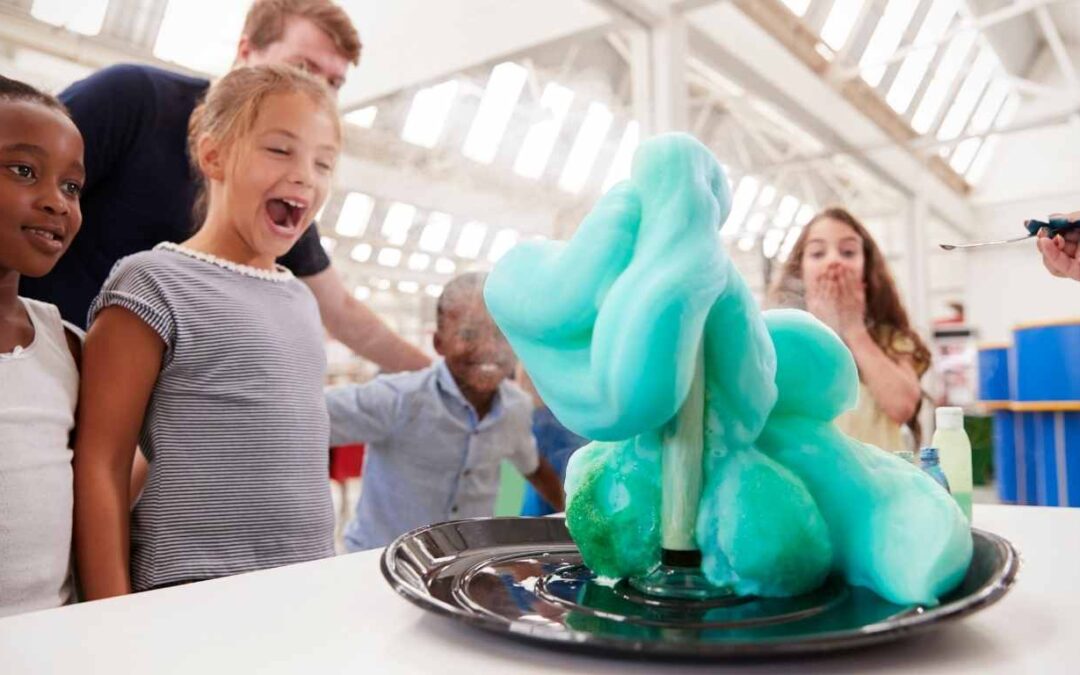It’s not always easy to make time for science. To discover the importance of science in the lives of all students, see Why Science?. To get practical tips on how to fit science into your homeschool schedule, read on! Find ideas to teach science at home to fit students of any age or learning style.
For Elementary Students:
Encourage Play
Part of science is discovery. Young kids discover best using all their senses, including touch. Making a baking soda and vinegar volcano? Invite those small hands to feel it, before and after the reaction. Making slime or quicksand are other tactile experiences that encourage play. Remember: it’s okay to get messy!
“I wonder…”
Many famous inventions began with a simple question. Encourage your young scientists to ask questions, and be curious about the world around them. If they say “I wonder what will happen…” let them try it! If they have a question, help them seek out the answer.
Museums
Is there a Children’s Museum in your area? What about a Museum of Natural History or Science Museum? Consider getting a family membership. Trips to see changing exhibits will pay off in meaningful science experiences.
Unit Studies
Is your fourth grader interested in space travel? He would love a unit on Astronomy and Planets. Is your second grader an aspiring artist? She might like drawing in a Science Notebook during a nature study. Whatever your child’s natural interests are, guide them to discovering their full potential.
 Summer Projects
Summer Projects
Summer school? Ugh. Make learning fun with a DIY Science Camp (focus on one unit of study, such as ocean animals). You could also take a Scavenger Field Trip, or spend warmer months building an Insect Collection with your kids.
Field Trips
Want to go on more field trips this year? Exploring the natural world is a great way to do that. Consider what attractions are nearby. Plan a day at the beach, a walk in the woods, or a trip to a national park or monument. You could also spend a day on a farm, or take a factory tour.
Zoos and National Parks
Zoo guides and park rangers are often knowledgeable and passionate about their fields of study. They’re great resources for a memorable science lesson. Plus, it doesn’t get more hands-on than seeing animals in person, instead of reading about them in a book.
Trade Off
Consider teaching history one week, and science the next. Or do a science unit followed by a history unit. Make sure you’re covering the topics you need to by planning out a month or year at a time. DON’T break in the middle of a topic to pick it up later. You could even consider trading off with another homeschooler – she’ll teach history, if you teach science, or vice versa.
Keep it Consistent
Have time each week devoted to science. Start small if you need to. Read for 10 minutes each day, plus have an hour for projects on Friday, for example. Or have one entire afternoon devoted to just science. You choose what works best for your homeschool–and stick with it.
For Junior High and High School Students:
Shadow a Scientist
Know someone in a field of engineering or technology? Have your high school student shadow them for a half day. Make sure your student prepares questions to ask the scientist.
Learn Through Independent Study
Think about your student’s interests, skills, and ability to work on their own. Select a topic of study together, and narrow it down into a semester-long unit. Have older students keep a science notebook, photo blog, or other project to summarize their learning.
Have Older Students Guide Younger Students
If you want to master something, teach it to someone else. If you want your high school junior to master basic science skills have her teach them to a younger sibling. Let older students develop a simple experiment or lesson with a key objective in mind. This benefits both the older student and the younger student. And gives mom or dad a break! Students could also work together on a dissection project (check out our handy dissection guides and dissection tools!) or microscope lab.
Incorporate Science with Other Subjects
ART – study the innovations in art and architecture that changed the world. Brunelleschi’s dome is a scientific marvel. The invention of oil paint changed the face of art.
HISTORY – add to a study of world history with some homemade inventions. If you’re studying the Wright Brothers, make your own flying machine out of paper.
MATH – are you studying measurements? See things in a different way, by taking a look at this interactive scale of the universe* (using a base 10 system). You could also look for a great STEM project or unit, such as robotics or programming.
*please note that the website linked to above is not affiliated with Home Science Tools. While we don’t necessarily agree with all information on this website, we thought this feature was pretty cool, and you might too.
Keep it Consistent
Whether you’re using a curriculum or trying unschooling, you need to schedule time for reading a textbook or doing research. Each week should also include hands-on experiments or projects for the best ideas to teach science at home. Plan a time to do science, and stick with it.





